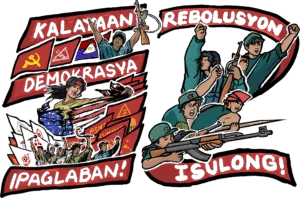1. Before World War II, 1926 to 1941
Under the auspices of the Third Communist International (Comintern), communist parties were established in Southeast Asia before World War II. The earliest to be established was the Communist Party of the East Indies in 1920. It had the distinction of being the first communist party in the whole of Asia. It led an armed uprising for national liberation against Dutch colonialism in 1926, the first armed struggle in the region led by a communist party. The armed uprising was brutally suppressed by the Dutch colonialists but gave the Communist Party of Indonesia the highest prestige as the fighter for the national liberation of the Indonesian people.
Under the shadow of the Great Depression and upon the intensified work of the Comintern, the Communist Party of the Philippine Islands, the Communist Party of Indochina and the Communist Party of Malaya were organized in quick succession in 1930. The Vietnamese communists launched in 1930 and 1940 uprisings against French colonial rule. Both failed but raised the prestige of the communists as fighters for national and social liberation. The Communist Party of the Philippine Islands was suppressed by the US colonial authorities a few months after its founding. The exile and imprisonment of the principal leaders served to pressure the legal cadres to stay within the bounds of legalism with regard to the questions of national liberation and agrarian revolution.
The peasant masses were severely exploited in these countries. Thus, there were spontaneous peasant uprisings in the 1920s and 1930s in Southeast Asia. But in general the communist parties were not able to systematically arouse, organize and mobilize the peasants for the purpose of waging a protracted people's war against colonialism and feudalism through the encirclement of the cities from the countryside until the accumulation of armed strength made possible the seizure of political power in the cities.
The main thrust of the political work of the communist parties in the 1930s was to oppose the Western colonial powers and seek national liberation through all forms of struggle. Like the Filipino, Indonesian and Indochinese communists against US, Dutch and French colonialism respectively, the Malayan and Burmese communists were so focused on opposing British colonialism that it took sometime for them to accept entirely the decision of the Seventh Congress of the Comintern in 1935 to focus the revolutionary struggle against the fascism of Germany, Italy and Japan and develop the popular front with forces associated with the Western colonial powers but were opposed to fascism.
The Southeast Asian communist parties gradually took the anti-fascist position and more quickly after Japan launched a full-scale invasion of China in 1937. However, in the case of the newly-established Communist Party of Burma, principal party leaders Thakin Aung San went to Japan in 1939 for military training against British colonialism and came back to form the Burmese National Army. Japanese fascism had been using the slogans of nationalism and Asian economic co-prosperity sphere to oppose the Western colonial powers in Southeast Asia.

